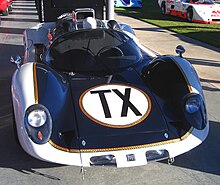I was looking for stuff to load onto the Classic Car Racers Forum, thats run by people from the WPMC here in Cape Town.
I then remembered a trip to Oulton Park, a very (really) nice race car circuit in Cheshire, England in 1968, the same year I emigrated to South Africa. Seems I made the right choice that day, the Howmet Turbine was new and to me very exciting, it was fast, the engine turned at 57,500 rpm but weighed just 170 pounds, thats about 70kgs only, to give you an idea what that means, the Hillman Imps alloy engine and transaxle weighs 76 kgs!
Now what would a V6 or V8 pushing out around 360bhp weigh?
I wonder how many viewers of this blog ever saw or heard this car?
Try this and you will soon know http://www.youtube.com/watch?v=l4PMalIwoo0
You knew when it was about to arrive by the sound of its motor as it can be heard from at least three corners away! It is now 46 years since I saw it racing, looks rather good I think.
More on this car can be found here http://website.lineone.net/~pete.stowe/pete_howmet.htm
What a car, I am so pleased that it still exists after all these years.
Roy
I then remembered a trip to Oulton Park, a very (really) nice race car circuit in Cheshire, England in 1968, the same year I emigrated to South Africa. Seems I made the right choice that day, the Howmet Turbine was new and to me very exciting, it was fast, the engine turned at 57,500 rpm but weighed just 170 pounds, thats about 70kgs only, to give you an idea what that means, the Hillman Imps alloy engine and transaxle weighs 76 kgs!
Now what would a V6 or V8 pushing out around 360bhp weigh?
I wonder how many viewers of this blog ever saw or heard this car?
Try this and you will soon know http://www.youtube.com/watch?v=l4PMalIwoo0
You knew when it was about to arrive by the sound of its motor as it can be heard from at least three corners away! It is now 46 years since I saw it racing, looks rather good I think.
More on this car can be found here http://website.lineone.net/~pete.stowe/pete_howmet.htm
What a car, I am so pleased that it still exists after all these years.
Roy
Click on the picture to enlarge it. My thanks to Wikipedia for the pictures and the information below.
http://en.wikipedia.org/wiki/Howmet_TX
Interest in the use of gas turbines as an alternative
to the piston
engine had been gaining support in the automobile industry during the 1960s.
Chrysler had begun testing in the
1950s and began leasing their Turbine Car to the public in 1963,[3] while
British manufacturer Rover and racing team BRM combined to build a racing car for the 24 Hours of Le
Mans in 1963 and 1965.[4] Both cars
showed reliability but were unable to win over the public or to win at Le Mans
respectively.[5] By 1967, team
owner and car developer Andy Granatelli had created the STP-Paxton
Turbocar for the Indianapolis 500. The car nearly won the race
driven by Parnelli
Jones, but suffered a mechanical failure after leading over two-thirds of
the event.[6] A
similar attempt with a Lotus 56 in
1968 also led to retirement after showing winning potential.[5]
At the same time as
Granatelli's turbine debut at Indy, racer Ray Heppenstall began to conceive a
design for his own sports car to make use of a gas turbine, improving in some
areas where the Rover-BRM had
failed several years before. Heppenstall felt that a more simplified design for
the chassis could make a turbine-powered car more competitive. Heppenstall
originally proposed the car to Allison Engine Company and later to Williams
Research.[7] He
eventually turned to fellow racer Tom Fleming for aid. Fleming was at the time
vice-president of Howmet
Corporation, which provided castings for turbines in the aerospace industry.
Heppenstall and Fleming were able to convince Howmet that their backing of a
competitive and unique sports car could promote public awareness of the company.
Howmet agreed to fund the project, lending their name to the car.[1]
Chassis[edit]
Heppenstall began the
project by purchasing a Cooper Monaco sports car, but later decided
it was not the best choice for a turbine and the car was sold off.[7] Bob
McKee, owner of McKee Engineering, was then contracted by Heppenstall to build
two cars brand new. The first space frame chassis was actually built from an
older McKee car initially built for the Can Am series in 1966, but adapted to house the turbine
engine.[5][8] The second
car #GTP2 was built from scratch, allowing it to be purposely designed around
the use of a turbine engine, including a chassis 2.25 inches (57 mm) longer.[1] The
chassis were known as the Mk.9 to McKee, but only ever raced as turbines under
the Howmet TX guise.[8]






No comments:
Post a Comment